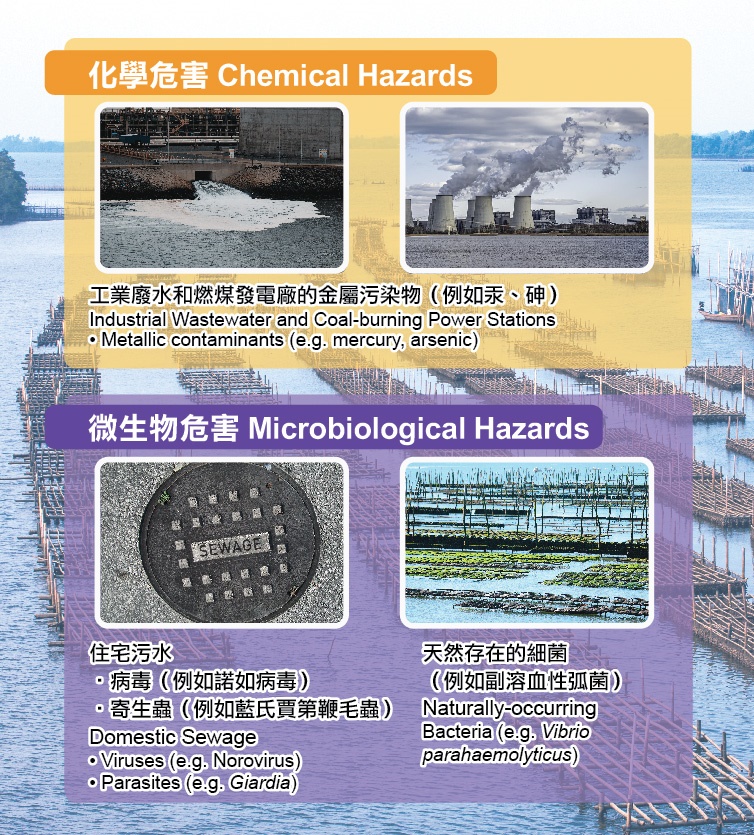
Food Safety Focus (209th Issue, December 2023) – Article 1
Minimising Health Risk on Oyster Consumption
Reported by Mr. Kenneth YIP, Scientific Officer,
Risk Communication Section, Centre for Food Safety
Oysters are filter feeders and susceptible to contamination from both pathogens and chemicals, which pose potential food safety risks. Consuming contaminated oysters can lead to food poisoning and health problems. This article will highlight the health hazards of oysters, surveillance conducted to monitor these hazards locally, and provide advice for lowering food safety risks from the consumption of oysters.
Hazards of Oysters
- Chemical Contaminants
Since oysters constantly draw in water, metallic contaminants such as cadmium, lead and mercury from the environment will be accumulated in oysters, especially in the internal organs and digestive tracts. Many industrial activities can lead to the discharge of metallic contaminants into the sea and hence oyster harvesting areas nearby may experience water pollution. Long-term consumption of oysters containing excessive levels of cadmium and lead may cause adverse health effects on kidneys and neurodevelopment.
- Pathogens
As oysters are usually cultivated in coastal environment, they can be contaminated by microorganisms and pathogens present in sea water, which can result in food poisoning. These include bacteria like Vibrio parahaemolyticus and Vibrio vulnificus, parasites like Giardia and Cryptosporidium etc. as well as viruses like norovirus and hepatitis A virus. Vibrio bacteria naturally live in coastal waters, whereas the major source of norovirus, hepatitis A and some parasites could be faecal pollution from humans.
- Antimicrobial-resistant microorganisms
It is more likely to contract antimicrobial-resistant (AMR) microorganisms through eating raw or undercooked oysters. Whether or not these AMR microorganisms can cause illnesses, they may transfer their AMR genes to other bacteria inside the human body, which will affect the effectiveness of the use of antibiotics in the future.

Figure 1: Possible sources of hazards and contamination for oysters.
Food Surveillance on Oyster Samples
Oysters and related products are included in the sampling scope of the Food Surveillance Programme conducted by the Centre for Food Safety (CFS). The CFS carries out chemical and microbiological tests on samples collected at import, wholesale and retail levels to ensure food safety. Recent surveillance findings revealed that apart from one imported fresh oyster sample detected with an excessive level of Escherichia coli, the results of the rest were satisfactory. As the season of oyster consumption approaches, extra oyster samples have been collected to safeguard public health. In a recent seasonal food surveillance project, the test results for metallic contaminants in all oyster samples were satisfactory.
How to Reduce Food Safety Risks when Consuming Oysters?
Oysters carry inherent food safety risk regardless of the season and region of harvesting. To date, there is no technology that can guarantee oysters are completely free of hazards. Maintaining a balanced diet and refraining from overindulgence in oysters can reduce the risk of exposure to excessive metallic contaminants.
To minimise the microbiological hazards, it is best to observe the Five Keys to Food Safety when handling oysters. Choose fresh oysters with intact shells and without abnormal odour, whereas the expiry date of prepackaged shucked oysters should be checked before purchase. Store chilled and frozen oysters properly at or below 4oC and -18oC respectively, and minimise the exposure time of raw oysters to room temperature. Wash hands thoroughly and put on protective gloves before handling oysters. Use different cutting boards and utensils to handle raw oysters and cooked or ready-to-eat food separately to avoid contamination. Only serve shucked raw oysters in small portions. Once shucked, oysters should be chilled at 4oC or below, protected from contamination and used within a day. If oysters are not intended for raw consumption, cook oysters thoroughly to minimise the risk of food poisoning.
When handling oysters, a number of procedures like rinsing and shucking are often done at room temperature. These handling procedures, when carried out at room temperature, should not exceed one hour. Before serving, oysters should not be left out at room temperature for longer than two hours in total.

Figure 2: Handling oysters exposed to room temperature for different durations
Key Points to Note
- Oysters may carry chemical and microbiological hazards.
- The CFS conducts food surveillance on oysters and related products.
- Following the Five Keys to Food Safety can reduce food safety risks of oyster consumption.
Advice to the Public
- Purchase and consume oysters from reliable food premises with licence/restricted food permits.
- Avoid overindulgence in oysters and maintain a balanced diet for minimising excessive exposure to chemical contaminants.
- Susceptible populations including the elderly, infants and young children, pregnant women and individuals with weakened immunity should avoid consuming raw oysters.
Advice to the Trade
- Collect oysters from reliable sources with health certificates issued by relevant authorities of the exporting countries or regions.
- Obtain permission in writing/endorsement from Food and Environmental Hygiene Department before selling raw oysters.
- Source oysters that are harvested from areas of clean water.

